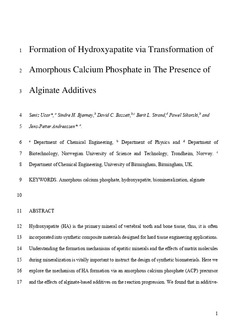Formation of Hydroxyapatite via Transformation of Amorphous Calcium Phosphate in the Presence of Alginate Additives
Ucar, Seniz; Bjørnøy, Sindre Hove; Bassett, David; Strand, Berit Løkensgard; Sikorski, Pawel; Andreassen, Jens-Petter
Journal article, Peer reviewed
Accepted version

Åpne
Permanent lenke
http://hdl.handle.net/11250/2641691Utgivelsesdato
2019Metadata
Vis full innførselSamlinger
Sammendrag
Hydroxyapatite (HA) is the primary mineral of vertebral tooth and bone tissue; thus, it is often incorporated into synthetic composite materials designed for hard tissue engineering applications. Understanding the formation mechanisms of apatitic minerals and the effects of matrix molecules during mineralization is vitally important to instruct the design of synthetic biomaterials. Here we explore the mechanism of HA formation via an amorphous calcium phosphate (ACP) precursor and the effects of alginate-based additives on the reaction progression. We found that in additive-free experiments the solution speciation was dominated by the classical formation of ion pairs prior to the emergence of an ACP phase, which was then followed by a transformation to HA. In the presence of alginate-based additives, ACP formation was retarded by several orders of magnitude due to kinetic hindrance and possible stabilization of intermediates, depending on the functionality of the molecules. ACP lifetime was also prolonged in the presence of additives, and this stabilizing effect was associated with the surface adsorption capacity of the additives which suggests a solvent-mediated transformation mechanism. When additives with G-units were introduced in the system, the final precipitates were composed of a mixture of octacalcium phosphate (OCP) and HA via effective suppression of HA formation. Our results demonstrate that compositional variations in the additive molecules strongly influence mineralization pathways.